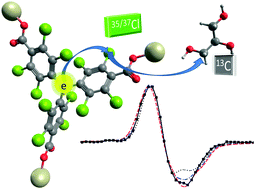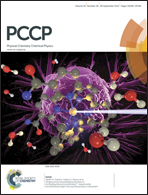The 13C solid DNP mechanisms with perchlorotriphenylmethyl radicals – the role of 35,37Cl†
Abstract
The microwave frequency swept DNP enhancement, referred to as the DNP spectrum, is strongly dependent on the EPR spectrum of the polarizing radical and it reveals the underlying DNP mechanisms. Here we focus on two chlorinated trityl radicals that feature axially symmetric powder patterns at 95 GHz, the width of which are narrower than those of TEMPOL or TOTAPOL but broader than that of the trityl derivative OX63. The static DNP lineshapes of these commonly used radicals in DNP, have been recently analyzed in terms of a superposition of basic Solid Effect (SE) and Cross Effect (CE)-DNP lineshapes, with their relative contributions as a fit parameter. To substantiate the generality of this approach and further investigate an earlier suggestion that a 35,37Cl–13C polarization transfer pathway, termed “hetero-nuclear assisted DNP”, may be in effect in the chlorinated radicals (C. Gabellieri et al., Angew. Chem., Int. Ed., 2010, 49, 3360–3362), we measured the static 13C-glycerol DNP spectra of solutions of ca. ∼10 mM of the two chlorinated trityl radicals as a function of temperature (10–50 K) and microwave power. Analysis of the DNP lineshapes was first done in terms of the SE/CE superposition model calculated assuming a direct e–13C polarization transfer. The CE was found to prevail at the high temperature range (40–50 K), whereas at the low temperature end (10–20 K) the SE dominates, as was observed earlier for 13C DNP with OX63 and 1H DNP with TEMPOL and TOTAPOL, thus indicating that this is rather general behavior. Furthermore, it was found that at low temperatures it is possible to suppress the SE, and increase the CE by merely lowering the microwave power. While this analysis gave a good agreement between experimental and calculated lineshapes when the CE dominates, some significant discrepancies were observed at low temperatures, where the SE dominates. We show that by explicitly taking into account the presence of 35/37Cl nuclei through a e–35,37Cl–13C polarization pathway in the SE-DNP lineshape calculations, as proposed earlier, we can improve the fit significantly, thus supporting the existence of the “hetero-nuclear assisted DNP” pathway.


 Please wait while we load your content...
Please wait while we load your content...